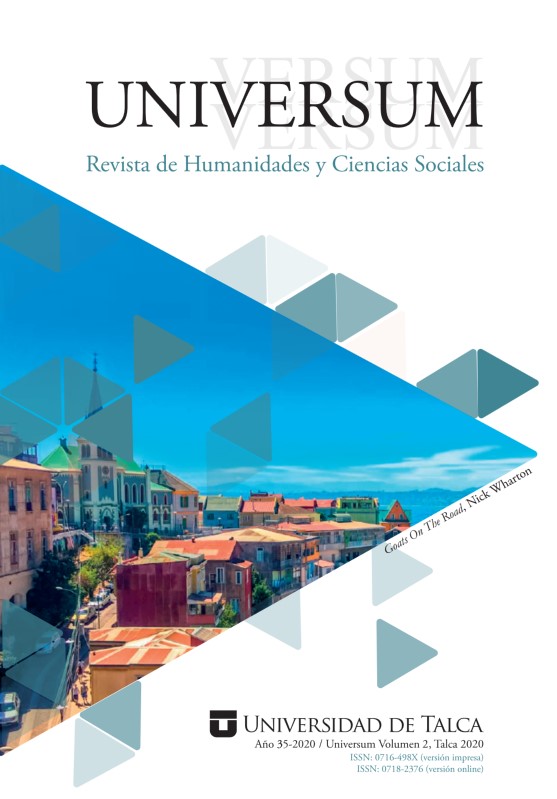Abstract
his paper aims to explore the farseeing contribution of the semiotician and literary theorist Yuri Lotman to the so-called spatial turn and, in particular, to the geocritical perspective. Taking into account Bertrand Westphal's words, according to whom "geocriticism is well present in the analysis of supposedly 'peripheral' areas, which contributes to relativize the 'marginality'" (Westphal 2007b: 329), emphasis will be placed here on Lotman's spatial-textual vision and its close relation with the semiotic-literary and cultural concept of boundary and "own-alien" space -vision resulting in what the French scholar would call a multifocal representation of reality.
References
Bulgákov, Mijaíl. El maestro y Margarita. Trad. de Valeria Korzeniewski y Alejandro Ariel González. Buenos Aires: Libros del Zorzal, 2015[1966- 1967]).
Burini, Silvia (ed.). "'Ecologia' della cultura: le Conversazioni di Jurij Lotman". Conversazioni sulla cultura russa. Florencia-Milán: Studi Bompiani, (2017):7-23.
Clowes, Edith W. Russia on the Edge: Imagined Geographies and Post-Soviet Identity. Ithaca-Londres: Cornell University Press, 2011.
García, Mariano, Punte, María José y Puppo, María Lucía (eds.). Espacios, imágenes y vectores. Desafíos actuales de las literaturas comparadas. Buenos Aires: Miño y Dávila editores, 2015.
Gherlone, Laura. Dopo la semiosfera (Con saggi inediti di JurijM. Lotman). Trad. de Bruno Osimo. Milano-Udine: Mimesis, 2014.
Lotman, Iuri. "Zametki o judozhestvennom prostranstve" (Notas sobre el espacio artístico), Trudy po znakovym sistemam (Semiotika prostranstva i prostranstvo semiotiki) XIX (1986):25-43. Disponible en: https://dspace.ut.ee/handle/10062/25250
____. Universe of the Mind: A Semiotic Theory of Culture. Londres-Nueva York: I.B. Tauris, 1990.
____. " O poniatii geograficheskogo prostranstva v russkij srednevekovyj tekstaj" (Sobre el concepto de espacio geográfico en los textos medievales rusos). Izbrannye stat'i v trej tomaj. 1: Stat'ipo semiotike i tipologii kul'tury. Tallinn: Aleksandra, 1992a [1965]:407-412.
____. "Problema judozhestvennogo prostranstva v proze Gogolia" (El problema del espacio artístico en la prosa de Gógol'). Izbrannye stat'i v trej tomaj. 1: Stat'i po semiotike i tipologii kul'tury. Tallinn: Aleksandra, 1992b[1968]:413-447.
____. "Para la construcción de una teoría de la interacción de las culturas (el aspecto semiótico)". La semiosfera. 1: Semiótica de la cultura y del texto. Trad. de Desiderio Navarro. Madrid: Ediciones Cátedra, Valencia: Universitat de Valência, 1996a [1983]):61-76.
____. "Acerca de la semiosfera". La semiosfera. 1: Semiótica de la cultura y del texto. Trad. de Desiderio Navarro (ed.). Madrid: Ediciones Cátedra, 1996b[1984]):21-42.
____. "O 'realizme' Gogolia" (Sobre el 'realismo' de Gógol'). O russkoi literature: stat'i i issledovaniia (1958-1993). San Petersburgo: Iskusstvo-SPB, 1997[1993]:694-711.
____. Vnutri mysliashchij mirov (Dentro de los mundos pensantes). Semiosfera. San Petersburgo: Iskusstvo-SPB, 2000a [1996]:150-390.
____. "El ensemble artístico como espacio de la vida cotidiana". La semiosfera. 3: Semiótica de las artes y de la cultura. Trad. de Desiderio Navarro (ed.). Madrid: Ediciones Cátedra, 2000b [1974]:113-122.
____. "La arquitectura en el contexto de la cultura". La semiosfera. 3: Semiótica de las artes y de la cultura. Trad. de Desiderio Navarro (ed.). Madrid: Ediciones Cátedra, 2000c[1987]:103-112.
____. "Besedy o russkoi kul'ture. Tsikl pervyi: Liudi. Sud'by. Byt" (Conversaciones sobre la cultura rusa. Primero ciclo: Gente. Destinos. Vida cotidiana). Vospitanie dushi. San Petersburgo: Iskusstvo-SPB, 2005[1986]:350-413.
____. Nepredskazuemye mejanizmy kul 'tury (Los mecanismos impredecibles de la cultura). Tallinn: TLU Press, 2010.
____. The Unpredictable Workings of Culture. Tallinn: TLU Press, 2013.
Lotman, Iuri; et al. "Tesis para el estudio semiótico de las culturas (aplicadas a los textos eslavos)", Entretextos 7(2006[1973]):54-86.
Pilshchikov, Igor (ed.). Urban Semiotics: The City as a Cultural-Historical Phenomenon. Tallinn: Tallinn University Press, 2015.
Semenenko, Aleksei. The Texture of Culture: An Introduction to Yuri Lotman’s Semiotic Theory. Nueva York: Palgrave Macmillan, 2012.
Soja, Edward. "Taking Space Personally". The Spatial Turn: Interdisciplinary Perspectives. Barney Warf y Santa Arias (eds.). Londres-Nueva York: Routledge, (2009):11-35.
Tally Jr., Robert T. (ed.). Geocritical Explorations: Space, Place, and Mapping in Literary and Cultural Studies. Nueva York: Palgrave Macmillan, 2011.
____. The Routledge Handbook of Literature and Space. Londres-Nueva York: Routledge, 2017.
Warf, Barney y Arias, Santa (eds.). "Introduction: The Reinsertion of Space into the Social Sciences and Humanities". The Spatial Turn: Interdisciplinary perspectives. Londres-Nueva York: Routledge, (2009):1-10.
Westphal, Bertrand. "Pour une approche géocritique des textes". La Géocritique: mode d'emploi. Bertrand Westphal (ed.). Limoges: Presses Universitaires de Limoges, (2000):9-40. Disponible en: http://sflgc.org/bibliotheque/westphal-bertrand-pour-une-approche-geocritique-des-textes/
____. La géocritique: réel, fiction, espace. París: Les Editions De Minuit, 2007a.
____. "Géocritique". La recherche en littérature générale et comparée en France en 2007: bilan et perspectives. Anne Tomiche y Karl Zieger (eds.). Valenciennes: Presses universitaires de Valenciennes, (2007b):325-334.
____. "Geocrítica", trad. de Ximena Figueroa Flores y Ninoska Vera Duarte, Bagubra. Revista de literatura y pensamiento desde Valparaíso, 3 (2015):123-131. Disponible en: http://bagubra.ucv.cl/pdf/Edicion3/Archivos/arc03XimenaFigueroa.pdf
____. La cage des méridiens: la littérature et l'art contemporain face à la globalisation. París: Les Editions De Minuit, 2016.
Zivkovic, Yvonne. "bell hooks' Affective Politics of Space and Belonging". The Question of Space: Interventions on the Spatial Turn Between Disciplines. Marijn Nieuwenhuis y David Crouch (eds). Oxford: Rowman & Littlefield, (2017):145-173.

This work is licensed under a Creative Commons Attribution-NonCommercial 4.0 International License.


